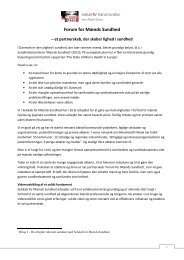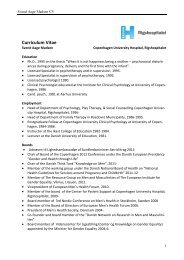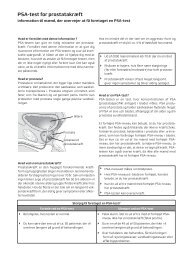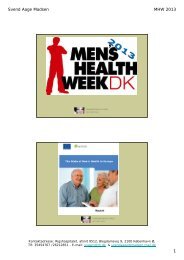Untitled
Untitled
Untitled
You also want an ePaper? Increase the reach of your titles
YUMPU automatically turns print PDFs into web optimized ePapers that Google loves.
Health Status<br />
Main points<br />
• Men generally identify themselves as having better health than women,<br />
although this may not accurately reflect their actual level of health and<br />
wellbeing.<br />
• Life expectancy is lower for men across all the EU Member States, ranging<br />
from 66.3 years for men in Latvia (77.6 yrs for women) to 80 years for men<br />
in Iceland (82.2 yrs for women).<br />
• There are more variations found between men’s life expectancy between<br />
different countries and regions than between men and women’s life<br />
expectancy.<br />
• Men have nearly double the potential years of life lost as compared to<br />
women, with large differences also evident between the countries.<br />
• For the EU27 it can be seen that the rate of death is higher for men across<br />
all age ranges, with 24 % higher rate in the 0-14 year age range, 236 %<br />
higher in the 15-44 age range, 210 % higher in the 45-64 age range and a<br />
50 % higher rate of death in the over 65 age range<br />
• The rate of premature death in men still far exceeds that for women, and is<br />
evident across the majority of disease states.<br />
• Over 630,000 male deaths occur in working age men (15-64 years) as<br />
compared to 300,000 women.<br />
• Infant mortality tends to be higher in boys.<br />
• Cardiovascular disease is still the biggest cause of premature death, but this<br />
is rapidly being replaced by cancer.<br />
Summary<br />
Men report better health than women and have lower levels of self reported<br />
chronic morbidity, but their life expectancy remains lower across all the<br />
countries. The gap between male life expectancy across different countries<br />
and regions is more marked than that between males and females, suggesting<br />
that men are more vulnerable to social circumstances. The biggest challenge<br />
facing men with regard to the mortality figures is in relation to their higher<br />
levels of premature death, with over 2.5 times more young men (aged 15-<br />
44 years) dying than young women across EU27. These deaths are also seen<br />
across nearly the whole spectrum of those health conditions that could affect<br />
men and women equally as they are not sex-specific.<br />
The burden of death appears to differ across the countries with those in<br />
Eastern Europe having higher rates of death as a result of cardiovascular<br />
11








